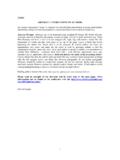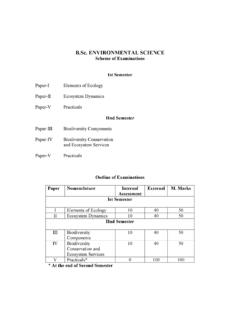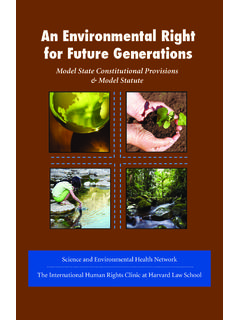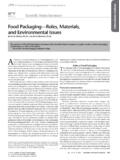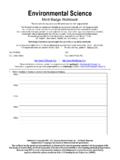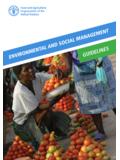Transcription of 9th International Conference on Environmental …
1 9th international conference on environmental Science and Technology Call for Abstracts Advance Registration Call for Free Exhibits Sponsored by American Academy of sciences Hilton Houston Hotel Houston, Texas, USA. June 25-29, 2018. International Conference on Environmental Science and Technology The objective of the Ninth International Conference on Environmental Science and Technology will be to provide a major interdisciplinary forum for presenting new approaches from relevant areas of Environmental science and engineering, to foster integration of the latest developments in scientific research into engineering applications, and to facilitate technology transfer from well-tested ideas into practical products, waste management, remedial processes, and ecosystem restoration.
2 Reports on renewable energy research are especially desired. Environmental humanity and sociality such as Environmental ethics, Environmental law, Environmental economy and Environmental management are also included in the scope of the Conference . Researchers, engineers, site managers, regulatory agents, decision-making officials, consultants, and vendors will all benefit from the opportunity to exchange information on recent research trends, to examine ongoing research programs, and to investigate world-wide public and regulatory acceptance of Environmental protection and remediation technologies.
3 Environmental disturbance and pollution are complex problems worldwide. The current development of modern science and technology combined with management on social and economic activities are contributing more and more to solution of the problems. Although considerable Environmental protection work has been and is presently being conducted, a multidisciplinary platform for Environmental scientists, engineers, management professionals and governmental officials to discuss the latest developments in Environmental research and applications will be very helpful for protecting our global village.
4 The Conference Chair is Professor George A. Sorial of University of Cincinnati, Ohio, USA. Sponsors and the participating partners of the Conference will include governmental, academic, and private organizations that are International leaders in Environmental research and technology applications. 1. Presentation Topics The Conference program will be comprised of several hundred platforms and poster presentations, organized into sessions that will address a variety of disciplines and technologies as well as contaminants. The sessions will be chaired by internationally recognized leaders in Environmental sciences and technologies.
5 The following is a tentative list of sessions; the list will be revised as necessary or appropriate during the abstract review process. 01. Water Pollution and Water Quality Control 01-01 Rivers, Lakes and Estuary Systems 01-02 Watershed Management 01-03 Water Resources and Assessment 01-04 Groundwater 01-05 Non-point Sources 01-06 Wastewater Discharge Management 01-07 In-Situ Measurement and Monitoring 01-08 Drinking Water 01-09 Water Quality Assessment/Management 01-10 Nitrogen-Phosphorus Wastewater Treatment 01-11 Sludge Treatment 01-12 Municipal Wastewater Treatment 01-13 Industrial Wastewater Biotreatment 01-14 Adsorption/Desorption for Wastewater Treatment 01-15 Physico-chemical Wastewater Treatment 01-16 Reactions and Degradation of Wastewater Contaminants 01-17
6 Nanotechnology Applications 01-18 Other Topics 02. Air Pollution and Air Quality Control 02-01 Aerosol 02-02 Air Quality Assessment 02-03 Transport of Air Pollutants 02-04 Waste Gas Control Techniques 02-05 Air Pollutant Monitoring 02-06 Hazardous Gas Biofiltration 02-07 Catalysts for Reducing Emission 02-08 Fuel Gas DeSOx, DeNOx, and Metal Removal 02-09 Air Pollution Prevention and Management 02-10 Noise 02-11 Other Topics 03. Land (Soil, Solid Waste) Pollution and Remediation 03-01 Contaminants in the Subsurface 2. 03-02 Natural Attenuation of Contaminants 03-03 In-Situ Remediation 03-04 Solid Waste Management 03-05 On-site and Off-site Remediation 03-06 Landfill 03-07 Permeable Reactive Barriers 03-08 Waste Fuel Site Remediation 03-09 Waste Recycling 03-10 Radioactive Waste and Land Pollution 03-11 Phytoremediation of Organic Pollutants 03-12 Polymer Waste Recycling and Management 04.
7 Ecosystem Assessment and Restoration 04-1 Ecosystem Assessment 04-2 Nutrients and Functions of Ecosystems 04-3 Restoration of Ecosystems 04-4 Urban Ecosystems 04-5 Other Topics 05. Bio-Assessment and Toxicology 05-1 Human Exposure 05-2 Bio-response and Ecotoxicology 05-3 Bioavailability and Bio-accumulation 05-4 Microbiology and Microbial Degradation 05-5 Other Topics 06. Wetlands 06-1 Wetland Conservation 06-2 Wetlands for Wastewater Treatment 06-3 Other Topics 07. Sediments 07-1 Assessment of Sediments 07-2 Remediation of Contaminated Sediments 07-3 Other Topics 08. Global Change 08-1 Global Warming and its Impacts 08-2 Carbon Discharge Reduction 08-3 Other Topics 09.
8 Metals 09-1 Metal Distribution 09-2 Metal Removal and Remediation 09-3 Speciation, Bioavailability and Accumulation 3. 09-4 Phytoremediation 09-5 Other Topics 10. Chlorinated and Other Persistent Organic Compounds 10-1 Characterization of Organic Pollutants 10-2 Degradation of Persistent Organic Pollutants 10-3 Other Topics 11. Modeling 11-1 Environmental Simulation 11-2 Water Quality Modeling 11-3 Inverse Model and Pollution Estimation 11-4 Other Topics 12. GIS, Database, and Remote Sensing 12-1 GIS for Environmental Assessment 12-2 Data Management and Statistics 12-3 Environmental Remote Sensing Applications 12-4 Other Topics 13.
9 Environmental Analysis and Measurements 13-1 Environmental Analysis 13-2 Field Measurement Technologies 13-3 New Method Applications 13-4 Environmental Monitoring 13-5 Other Topics 14. Society and the Environment 14-1 Society and the Environment 14-2 Environmental Ethics and Laws 14-3 Environmental Education 14-4 Other Topics 15. Sustainable Development and Environmental Management 15-1 Environmental Quality and Planning 15-2 Sustainable Development 15-3 Environmental Policy and Management 15-4 Other Topics 16. Renewable Energy Development & Energy Conservation 4. 16-1 Water Energy Nexus 16-2 Wind Energy 16-3 Solar Energy 16-4 Bio Fuels (Methane, Ethanol, ).
10 16-5 Other Renewable Energy Topics Abstract Submission Abstracts are to be prepared and submitted electronically according to the instructions given below. Content. The abstract should provide a brief summary of the research including: introduction, objectives, methods, results and conclusions. Case studies with novel approaches are especially desired. Format. Abstracts (written in English) cannot exceed one page and must be prepared using standard PC- based MS Word software. Use an 11-point serif font ( Times New Roman) and leave 1-inch ( ) margins left, right, top, and bottom. Center the title (maximum 20 words, title case, bold type) at the top of the page.
